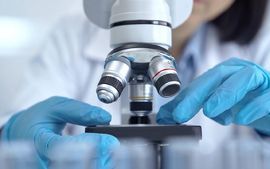- Published:
- 22 April 2025
- Author:
- Dr Esther Youd
- Read time:
- 4 Mins
As reported in the Autopsy training survey – reporting on histopathology trainees’ experience of autopsy training article in this Bulletin issue, the trainee subcommittee of the College’s Death Investigation Committee recently conducted a survey of the experience of autopsy training among histopathology registrars. Here, we hear from Dr Esther Youd, the Committee Chair, on the valuable insights which have been taken on board by the Committee, in hope of seeing the results leveraged into positive change for trainees.
The survey carried out by trainee Erin Whyte is a once in a generation picture of autopsy training from the perspective of trainees. A high response rate (around 50% of trainees) means the data is truly powerful and reflective. I want to send an enormous thanks to every person who participated and made the survey such a success. And, of course, huge thanks to Erin for the concept, design, commissioning and interpretation of the survey.
Here, I set out some personal reflections and some of the ways the Death Investigation Committee (DIC) has responded to the survey findings and already put into place improvements. There are some challenges for all autopsy pathologists providing training and simple ways to improve the training experience.
As an autopsy pathologist, of course, I believe that autopsy training is a vital part of histopathology training. Most pathologists are visual learners; seeing and feeling gross pathology in the autopsy room is important to really appreciate the basics of pathological mechanisms and understand disease.
It is well known that there are significant challenges to delivery of autopsy services across much of the UK, but particularly in England’s and Wales’ coronial services. There simply aren’t enough pathologists to do all the work required and something has to give, that thing often being autopsy work. It's poorly remunerated and often under-appreciated. The choices being made by consultants about what services to support and what to give up are impacting on training.
In this survey, we heard from trainees who see consultants juggling autopsy work, under pressure, and those trainees are making the choice not to follow in their footsteps. We also heard from trainees who spoke very highly of their autopsy training experience and there is much we can learn from this to share good practice.
For example, a simple change that can be easily made is to have a formal induction. Induction to the mortuary and autopsy service helps in understanding the various roles of mortuary staff and making a trainee feel comfortable and welcome in the mortuary when they attend to conduct an autopsy. For some trainees, interaction with anatomical pathology technicians (APTs) was a challenge; in some places, trainees feel like a burden. An induction can help with this, so trainees know what is expected of them, APTs know what is required for supporting the trainee, and trainees know how the APTs can help them and how they can help the whole mortuary team.
The survey report made 3 main recommendations. Some of the initial actions taken are described below.
Recommendation 1 was about leveling the playing field for all trainees to have access to high-quality information and training resources, regardless of where they are training. To this end we have:
- updated the information on the RCPath website about the CHAT exam (with thanks to Katherine Syred, CHAT Lead Examiner)
- added new resources to the Pathology Portal, including:
- post-mortem CT cases
- CHAT exam information
- more than 660 autopsy related resources now available
- approached the ST1 joint training lead to contribute to training in autopsy
- discussed with the Association of Anatomical Pathology Technology about holding joint training with APTs.
Recommendation 2 was a challenge to the College to use the information in this survey to leverage change for the future workforce to support training and autopsy practice. This should include:
- advocating for an increase in the number of training posts in histopathology (and related specialties, as autopsy practice often relies on the input of neuropathologists, paediatric pathologists and forensic pathologists, as well as specialists in cardiac pathology and bone pathology)
- advocating for improved remuneration for autopsy work
- continued support for higher autopsy training
- advocating for increased numbers of consultant histopathologists, paediatric pathologists and neuropathologists
- providing in-person and online training events for trainees.
Recommendation 3 was a challenge to education providers and service providers to find ways to address the challenges faced by trainees. To that end we have:
- presented the survey at the Cellular Pathology College Specialty Training Committee (CSTC) and discussed with training leads and educational supervisors
- learned from good practice
- shared the survey with all pathology Heads of School
- started making plans to present the survey to the Coroners Society of England and Wales.
I am grateful to all those who gave their time to take part in this survey and to Erin for the interpretation and honesty in sharing it. I am thankful to all who have listened as we presented the findings and who have taken up the challenge to improve the training experience.



